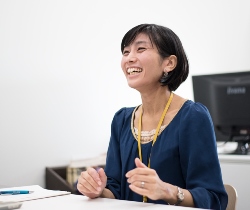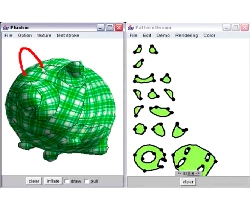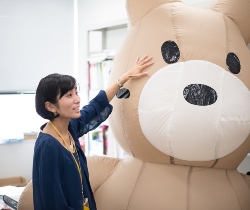Using CG to support manufacturing


The field of computer graphics has the largest academic society in the world, called SIGGRAPH (the Special Interest Group on Computer GRAPHics). In the past, most of the technologies presented at the academic society were drawings and shape data, and illustrations as seen on a computer screen to show how real they looked as photos. However, topics with fabrication (manufacturing and assembling) have been rapidly increasing over the past 10 years. This movement proposes technologies and CG with researchers’ perspectives to support beginners to create objects not only by seeing them on a computer screen but also touching them. In 2007, I also presented a system to support the making of original 3D stuffed toys called “Plushie.”
This software uses two monitors. One of them shows the 3D CG of stuffed toys and the other shows 2D patterns. Usually, the stuffed toy patterns are made by specialists by hand. As the patterns are made on a trial and error basis by craftspeople with their accumulated experience, it is very difficult for beginners without specialist knowledge to design the patterns. Therefore, I created a system that would display the shapes of completed stuffed toys as the simulation result once computers create patterns automatically based on the outlines of stuffed toys after the users drew the outlines of the stuffed toys they wanted to make just as they would do so with drawing software. For example, let’s say that you use a rectangular pattern, cut two pieces of cloth, sew them together, and fill them in with cotton. The completed shape would not be rectangular but a bit smaller sunken pillow-like shape. Therefore, when the system receives these rectangular outlines, it creates patterns so the completed shape would be rectangular. This is what my system does. However, the users will not see this internal calculation at all, and from the users’ point of view, they can check the completed aspects of 3D stuffed toys while drawing 2D outlines. The patterns are also automatically created.
Workshops are an important information source as I can meet the actual users
I hold workshops for elementary school children and their parents to use this software. At first, I explain how to use the software for about 30 minutes. Then later, children start making designs for stuffed toys. They draw outlines and horizontal lines to cut the object. They may also add prongs and stretch by pinching the parts… As the children make 3D designs, patterns are automatically created and the simulation of the completed object also changes. Children complete their designs in about 30 minutes like they were playing with drawing software. Then, they print the patterns they designed and sew them with their parents. It only takes four hours from start to finish to complete their original stuffed toys.
It is very important for my research to hold these workshops and observe children who actually use the software. Directly observing if children are truly enjoying the software and the software is supporting their creativity, or if they have any difficulties using the software can provide more important information than I imagine in our lab. For example, at the first workshop, there were children who could not create any designs even if I said, “Let’s create a design.” My staff and I could not tell whether the children were thinking of designs for their stuffed toys, or if they didn’t know how to design while having their own ideas or even they didn’t simply understand how to use the system. I then distributed pens and paper, and some children were able to create designs on paper. This is how I learned that each child has different concerns and that I needed to advise them depending on their designs. My goal was to also cultivate children’s creativity by letting them think of their own designs. However, I realized that it would be difficult to create a design from scratch. These experiences led me to develop a system that introduced interactive evolutionary computation to create original designs by combining stock designs from third parties when I developed software to design necklaces.
Motivation to cultivate children’s creativity

One of the goals for my research is to support craftwork for children and beginners, and to cultivate their creativity by using CG. I am researching technologies and developing software to design crafts, such as stencils and beads, in addition to stuffed toys.
Stencil is a design to apply ink over plates that images or words were cut out from. As this design must be restricted to connect these plates as one piece, it is very difficult to make complex designs. I therefore developed software that automatically makes one plate while users can draw images like normal without worrying about this restriction.
Bead designing is an art to create 3D craftwork, such as animals, by threading beads into one wire. It is extremely difficult to design these craftworks, and even specialists manually design the blueprints by repeatedly threading and unthreading beads on a trial and error basis while writing them down. I have developed a system called “Beady” so even beginners can make their own bead designs. This system can design polytopes with constant lengths of sides by simply drawing lines with a mouse by using a gesture interface when the users want an area to pop out a bit or connect the top with another top. This system offers users designing polytopes together with beads models that support beads, and 3D CG supports production as well. The system internally applies CG and mathematical theories, such as Eulerian graphs, which is a unicursal theory to make artwork using only one wire. I would like many users to experience the pleasure of create their own crafts by using these tools.
It is of course possible to cultivate creativity by making craftworks with milk packs without using digital devices for instance. Children used to cultivate their creativity by making and combining familiar objects around them to make craftworks in days past. Meanwhile, we are now able to experience fields that couldn’t in the past as computers have become widespread. There is no boundary between the real world and the virtual world nowadays due to the widespread use of social networking sites and wearable computers. We create designs using computers and make objects in the real world. I think it is interesting to cultivate creativity like this.
To research and develop these systems, I am always careful about what the system should and shouldn’t support. When the computer supports too much, children would become dependent on it and they would not think about what they should deeply consider. This is the tail wagging the dog. Recently, more classes at elementary school are encouraging children to speak out and foster their own ideas rather than being passive. Similarly to the intention of these classes, I believe that cultivating one’s creativity is to nourish the ability for each of us to think and act for ourselves.
The software that was introduced here has been uploaded to Dr. Igarashi’s website:
http://www.geocities.jp/igarashi_lab/
* The information contained herein is current as of November 2016.
* The contents of articles on M’s Opinion are based on the personal ideas and opinions of the author and do not indicate the official opinion of Meiji University.
Information noted in the articles and videos, such as positions and affiliations, are current at the time of production.

